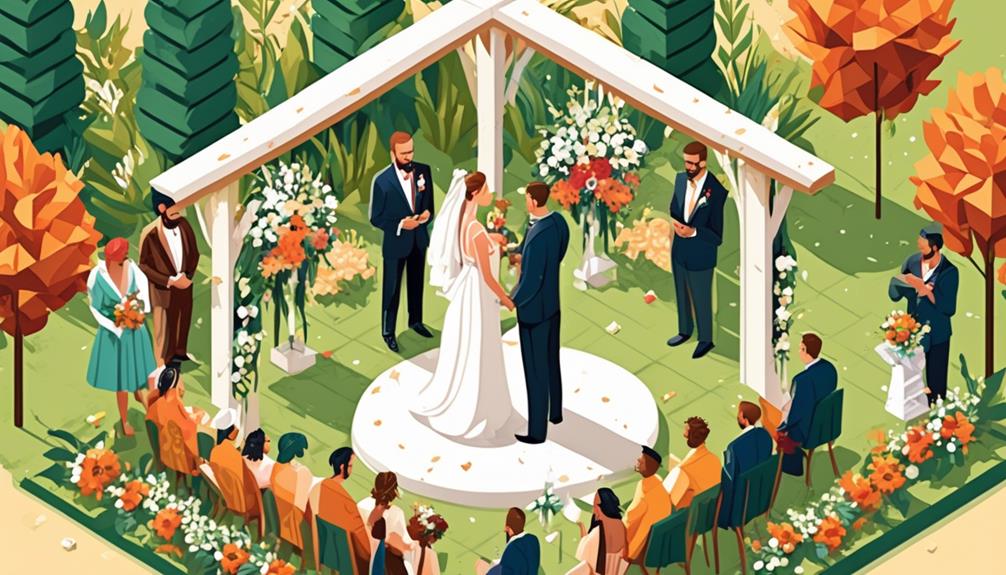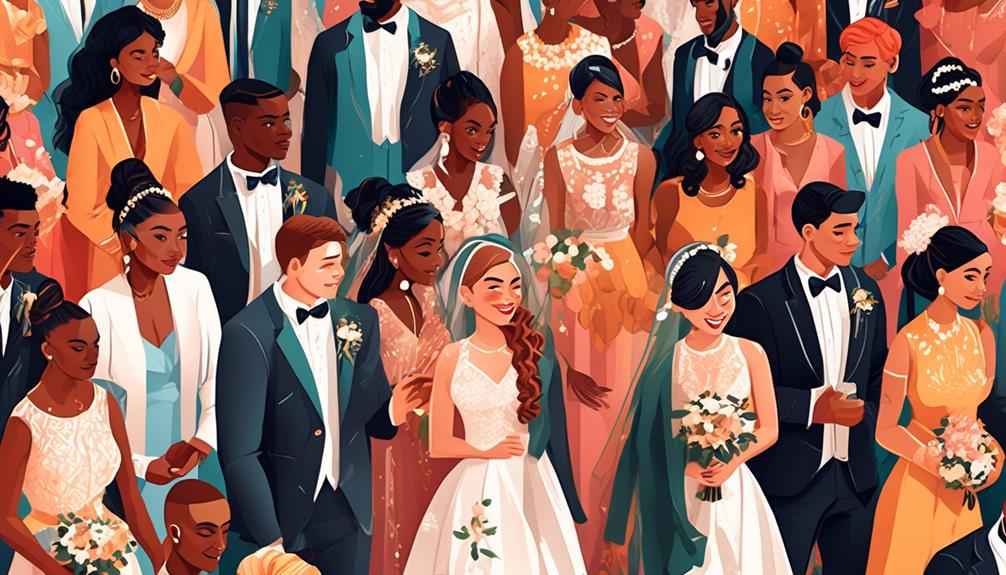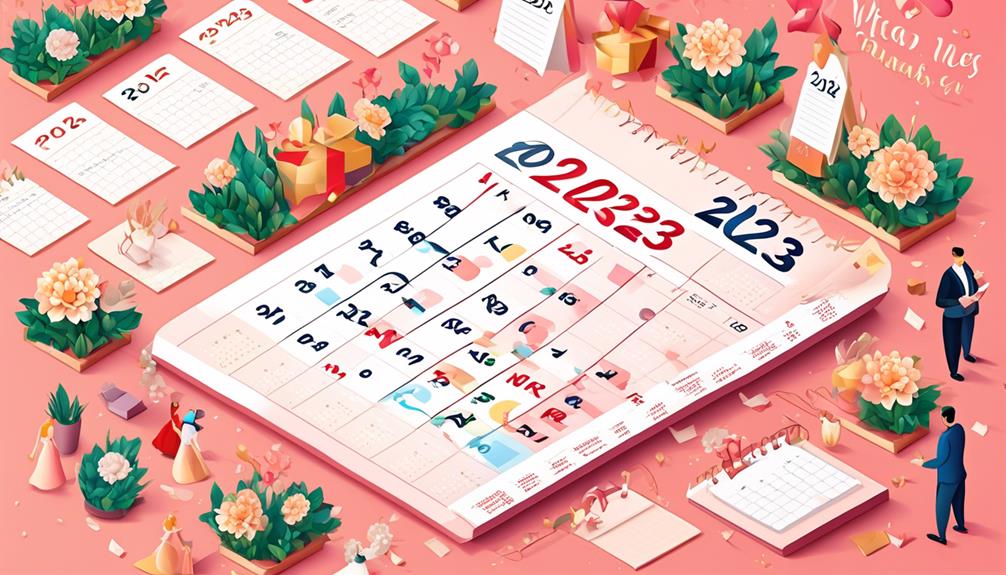Weddings are the pinnacle of human celebration, an event so grand that it seems to defy simple analysis. However, when you dig into the statistics, a fascinating world of trends, costs, and societal shifts emerges.
From the average price tag of a wedding to the impact of technology on planning, the data paints a vivid picture of how couples are approaching their big day. But what does this information reveal about the future of weddings? And how are changing attitudes and economic factors shaping the industry?
These are some of the questions we'll explore as we delve into the captivating world of weddings statistics.
Key Takeaways
- The average cost of a wedding has significantly increased, reaching $29,195 in 2022, with a substantial portion spent on venue and catering expenses.
- Summer and fall are the most popular seasons for weddings, with October being the top month for weddings in 2021.
- Weekend weddings are more common, representing 74% of all weddings, while weekday weddings offer cost-effectiveness and greater availability.
- Technology has had a significant impact on wedding planning, with 90% of couples using online platforms for communication, vendor selection, and even wedding invitations.
Average Wedding Costs
The average cost of a wedding has significantly increased in recent years, reaching $29,195 in 2022, reflecting a 33.5% surge from 2020. This substantial increase has made planning a wedding a more financially demanding endeavor.
A considerable portion of this expense goes towards securing a suitable venue, with some venues alone costing over ten thousand dollars. Additionally, the cost of the engagement ring, if included, raised the average cost of a wedding to $34,000 in 2021.
The bridal gown also constitutes a significant portion of the budget, with brides paying an average of $1,631 for the dress, including alterations, in 2020.
It's not just the couple bearing the financial burden; wedding guests also incur substantial expenses, with an average expenditure of around $776 for the wedding day, covering various costs such as travel and accommodations.
These figures underscore the escalating financial commitment associated with modern weddings, prompting couples and guests alike to navigate these events with greater financial mindfulness.
Popular Wedding Dates

I'll start by examining the peak wedding seasons, including the most popular months and days of the week for tying the knot.
We'll also explore whether couples prefer to have their weddings on holidays or special occasions.
It's interesting to see how these factors influence the choice of wedding dates and the overall wedding planning process.
Peak Wedding Seasons
Summer and fall stand out as the most popular seasons for weddings, with a majority of couples choosing these times of year to tie the knot. According to Businesswire, 77% of weddings take place during these seasons.
In 2021, October emerged as the top month for weddings, while December was the most popular month for engagements. However, weddings during peak seasons tend to be more expensive due to record levels of consumer price inflation, as reported by The New York Times.
Despite challenges such as supply chain shortages, the wedding industry is witnessing a surge in demand, with a record number of weddings expected in 2022, as per CNBC.
Additionally, nearly 20% of weddings in 2021 were destination weddings, with half of them hosted in international locations, according to Pearl Source.
Weekend Vs. Weekday
With weekend and weekday weddings each having their own appeal, the choice of wedding date can significantly impact the overall wedding experience. Considering the popularity of weekend weddings, it's important to weigh the advantages of weekday celebrations as well. Here are some key points to consider:
- Weekend weddings are more prevalent, constituting 74% of all weddings.
- Saturday is the top choice, representing 53% of weekend weddings.
Weekday weddings, particularly on Fridays, account for 26% of ceremonies. They offer cost-effectiveness and greater availability. They can provide a more intimate and relaxed experience for both couples and guests.
Understanding the distinctions between weekend and weekday weddings can help couples make an informed decision that aligns with their vision for their special day.
Holiday Preferences
In 2021, October emerged as the most favored month for exchanging wedding vows, with four of the top five wedding dates falling within this month. The popularity of October as a wedding month may be attributed to the pleasant autumn weather and the vibrant foliage, providing a picturesque backdrop for celebrations. Below is a table depicting the top five wedding dates in 2021, showcasing the prevalence of October:
| Rank | Wedding Date | Month |
|---|---|---|
| 1 | October 16 | October |
| 2 | October 9 | October |
| 3 | June 26 | June |
| 4 | October 23 | October |
| 5 | October 2 | October |
This data underscores the overwhelming preference for October as the ideal month for tying the knot in 2021.
Technology's Impact on Planning

Technology has revolutionized the wedding planning process, fundamentally altering the way couples communicate, make decisions, and coordinate with vendors. It's amazing to see how technology has reshaped the entire wedding industry.
Here are some key ways in which technology has impacted wedding planning:
- Online Planning: 90% of wedding planning is now done online, mostly on desktops, laptops, phones, and tablets.
- Communication: Couples are increasingly using technology for communication, with high usage of WhatsApp in India and wedding planning apps in Brazil, and over 50% of couples in the US video chatting with vendors.
- Invitations: Technology has influenced wedding invitations, with couples in Brazil and Mexico using digital means to communicate key details.
- Vendor Selection: Couples are now using technology to select vendors, with an average of ten vendors being hired and over 90% of couples in the UK, Canada, and Brazil hiring a photographer.
- Industry Trends: In the digital age, technology is shaping wedding industry trends, with projections indicating an increase in online wedding planning and the bridal industry's profitability and business outlook in 2023.
Trends in Wedding Traditions

The growing preference for outdoor ceremonies and receptions signifies a notable shift in wedding traditions. As the use of hand sanitizer at weddings decreased from 39% in early 2022 to 25% overall, it reflects a change in COVID-19 precautions. Couples are increasingly opting for outdoor venues, with only 8% changing from indoor to outdoor in 2021, down from 17% the previous year. This shift could be attributed to a desire for open-air settings and a more natural ambiance.
Moreover, there's a rising trend in the use of lab-grown diamonds, which accounted for 36% of center stones in 2022, doubling in popularity since 2020. This choice reflects a shift towards sustainability and ethical sourcing. Additionally, the average age to get married in 2022 was 31, indicating a trend towards older couples tying the knot. This trend could be a result of various factors such as career stability and financial readiness.
With the wedding industry expected to rebound from the impact of the COVID-19 pandemic, an increase in the number of weddings and industry revenue is anticipated, indicating a return to more traditional wedding celebrations.
Gen Z's Wedding Views

How do Gen Z couples approach wedding planning and traditions in today's digital age?
Gen Z couples are redefining wedding traditions and embracing modern approaches to planning their big day. Here are some key insights into how Gen Z views weddings:
- Tech-Savvy Planning: 90% of Gen Z couples rely on online resources for wedding planning, with 46% using a desktop or laptop, and 44% using a phone or tablet.
- Stable Wedding Dates: Only 7% of Gen Z couples had their wedding date impacted by COVID-19 in 2022, a significant decrease from the 27% in 2021, showcasing their adaptability and resilience.
- Engagement Trends: The average engagement length for Gen Z couples in 2022 was 15 months, with December being the top month for engagements. Additionally, 71% sought parental permission before proposing, highlighting the importance of family in their traditions.
- Ring Exchanges: 95% of Gen Z couples exchange rings, with diamonds being the most popular choice for the center stone at 85%, and the average amount spent on an engagement ring was $5,800, reflecting their appreciation for timeless symbols of commitment.
- Age and Meeting Partners: The average age for Gen Z couples to get married in 2022 was 31, and they were less likely to have met their partners online compared to Millennials, indicating a blend of traditional and modern approaches to relationships and marriage.
Economic Impact of Weddings

Experiencing a significant boost in economic activity, the wedding industry has shown remarkable resilience and adaptability in the wake of challenges posed by the COVID-19 pandemic. Despite the initial decline in weddings during the pandemic, the industry is expected to see a resurgence, with an anticipated 2.24 million weddings in 2023, marking a 62.5% increase since 2020. This resurgence is projected to lead to a substantial economic impact, with wedding services industry revenue in the United States expected to reach $70.3 billion in 2023.
| Wedding Expense | Average Cost (2022) |
|---|---|
| Engagement Ring | $3,756 |
| Wedding Ceremony and Reception | $29,195 |
| Venue | Varies |
| Catering | Varies |
The wedding industry encompasses a wide range of expenses, from the average cost of an engagement ring to the expenses associated with the ceremony and reception, venue, catering, and more, contributing significantly to the economy. As the industry adapts to changes in consumer behavior, such as a focus on more intimate, local, and outdoor events, as well as an increased reliance on online wedding planning, its economic impact remains substantial.
Planning for 2023

After analyzing the economic impact of weddings, it's time to shift our focus to planning for 2023 and the upcoming trends in the wedding industry.
- Personalization: Couples are increasingly seeking unique and personalized elements for their weddings, from custom decor to specialized catering options.
- Sustainability: With a growing awareness of environmental issues, there's a trend towards eco-friendly weddings, including sustainable materials, locally sourced products, and reduced waste.
- Technology Integration: The use of technology in weddings is expanding, with virtual elements such as live streaming for remote guests and digital RSVP systems becoming more prevalent.
- Micro Weddings: Intimate gatherings are gaining popularity, with couples opting for smaller guest lists and focusing on creating a more meaningful and personal experience for attendees.
- Inclusive Practices: More couples are embracing inclusivity and diversity in their wedding planning, including representation in vendors, imagery, and cultural traditions.
These emerging trends reflect a shift towards more personalized, sustainable, and inclusive wedding experiences in 2023.
Frequently Asked Questions
What Are the Most Popular Wedding Themes and Color Schemes for 2023?
The most popular wedding themes for 2023 include vintage romance, modern minimalism, rustic elegance, enchanted garden, and bohemian chic. Neutral palettes like soft blush and sage green are dominating, while sustainable elements and vibrant tropical themes are trending.
How Has Social Media Influenced Wedding Planning and Guest Interactions?
Social media has revolutionized wedding planning, connecting couples with inspiration, vendors, and guests. It creates an interactive experience, from sharing announcements to live updates during the event. Its influence has led to personalized hashtags, live streaming, and virtual guest participation.
What Are Some Emerging Wedding Traditions That Are Gaining Popularity Among Younger Couples?
As a younger couple, we're embracing personalized vows to share our unique love story. We're drawn to intimate, eco-friendly weddings with tech-savvy touches like live streaming. Non-traditional attire allows us to express our creativity and individuality.
Are There Any New Environmentally-Friendly Trends in Wedding Planning and Decor?
Yes, there are new environmentally-friendly trends in wedding planning and decor. Couples are choosing sustainable materials, upcycled decorations, locally-sourced floral arrangements, eco-conscious vendors, outdoor venues, and digital invitations to reduce their events' environmental impact.
How Has the Rise of Virtual Weddings and Live Streaming Affected the Wedding Industry?
The rise of virtual weddings and live streaming revolutionized the wedding industry, expanding inclusivity and reducing costs. It's like opening the doors to a global celebration. Couples now prioritize tech-friendly venues and digital-friendly photography to enhance remote viewers' experiences.
Conclusion
In conclusion, while wedding statistics provide valuable insights, some may argue that the industry is too focused on lavish spending.
However, it's important to remember that weddings are a significant life event for many couples, and the industry continues to evolve to accommodate a wide range of preferences and budgets.
So whether you're planning a traditional or modern wedding, there are plenty of options available to make your special day memorable and meaningful.










